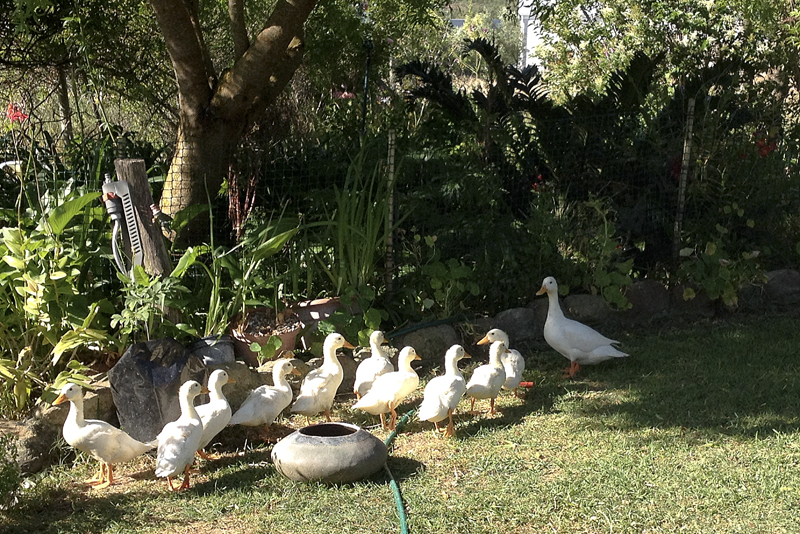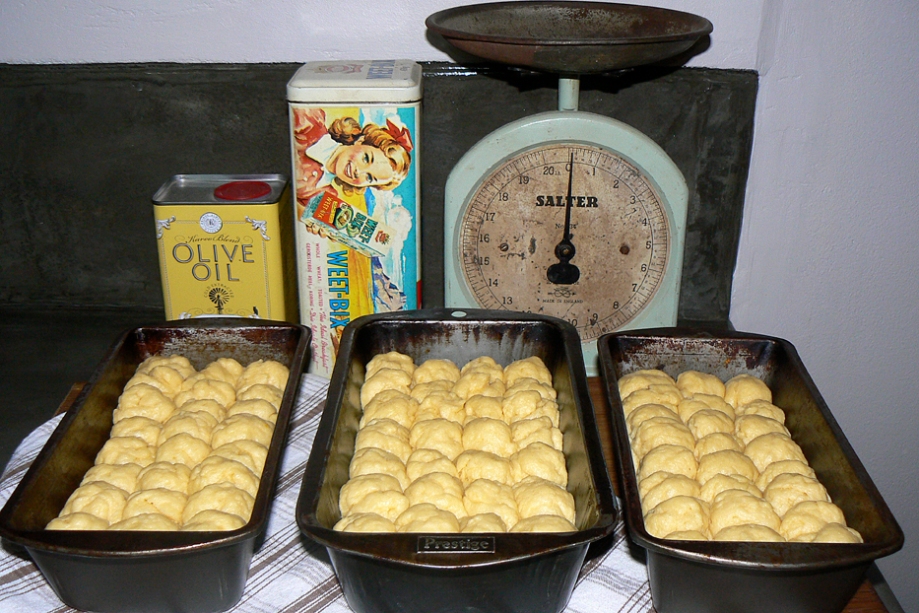A fortnight ago more waterfowl joined our flock at Landmeterskop. Ten Call Ducklings from friends, Basil and Bea Whittaker of Stanford, and also Chinese Geese and Indian Runner Ducks which we bought from John Faure of Vergenoegd Wine Estate. John is a waterfowl keeper with a difference: his show birds double up as a working flock at the vineyard. More about John and his ducks later…
We had to help catch the ten Call Ducklings or “Kwakertjies” (with their mother in the photo above), and this turned out quite a performance!!! Picture four grownups, three women between the ages of 55 and 65, of varying sizes from very slim to comfortably round, and one guy, also in his sixties, running after or “lying in ambush” behind shrubs and pots to catch the ducklings who were trying their ultimate best not to be caught, all the while quacking as if they were being murdered. Then, to that picture, add four Bassets of varying ages barking, and another dog of mixed breed trying to help with herding the ducklings, and one of the Bassets (the only one temporarily tethered to a tree) getting hold of one of the ducklings and humans shouting commands on what to do now, how to do this, where to stand, and you might get the picture! Valerie swiftly rescued the poor thing from the Basset’s clasp and at last, after almost an hour and some excellent tackling work from Valerie which I might say, would put some of our rugby players to shame, all ten ducklings were caught and put into cardboad boxes and transported to their new home at Landmeterskop. They quickly adapted to the freer lifestyle – look at them swimming in the dam below…
More about John Faure as promised:
http://www.vergenoegd.co.za/Do.aspx?DOID=454&CLIENTID=3483&Title=Attractions
http://www.runnerduck.net/south_africa/
“John Faure of Vergenoegd’s family has lived in South Africa for over two centuries. The house dates back to 1773, and wine making has been a family business since 1820. Vergenoegd hosts its visitors at the winery’s restaurant, and the Runners have become a starattraction, especially when the ducks are herded onto the lawn after the day’s work foraging for snails. This duck parade, and the swim on the ‘dam’ (lake), has become a real photo opportunity, and must advertise the Indian Runner as ‘the duck to have’ in SA. John is a keen breeder, exhibitor and judge, winning Showman of the Year for 2009. His birds are top quality stock, some of them having originated in the USA. He has good quality dark-phase Mallard Runners as well as Buffs, Black, White, Blue and even Trout and Apricot Trout. As you can see from John’s photos, the birds are a super type. They were photographed in December – not the best time for the southern hemisphere of course.
John has joined the increasing number of waterfowl breeders becoming globe-trotters. In the summer of 2009 the family, which has ties in the Isle of Man, visited the UK and also did a round tour of breeders Chris & Mike Ashton, Graham Barnard, Graham Hicks, Denise Moss and Anne Terrell. He’s a member of the Indian Runner Duck Association, and interested in the colour genetics of the birds.
On his return to South Africa, the incubators were full, and the first lot of hatchlings growing to be ready, by October, to join the other working ducks in the vineyards. Whilst John experienced a lot of rain here in the wet summer of 2009, they also had an exceptionally wet winter in South Africa. The snails did thrive, and presented a much bigger problem, in the foliage and bunches of grapes, than usual. So the working ducks, tall enough to reach up well into the vines, were in big demand to help produce the wine which, of course, has their image on the label.















